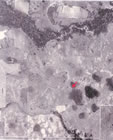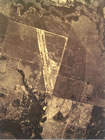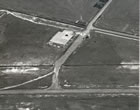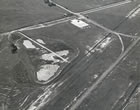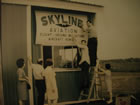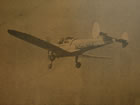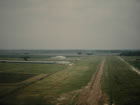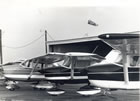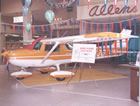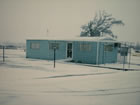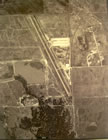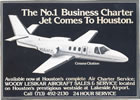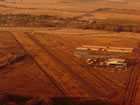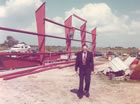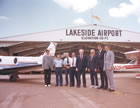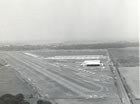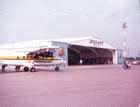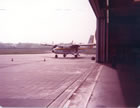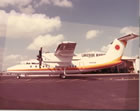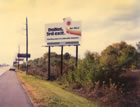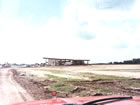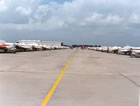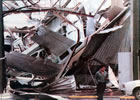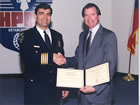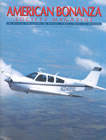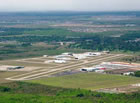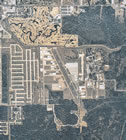HISTORY OF IWS
HISTORY OF WEST HOUSTON AIRPORT
OUR LEGACY
In 1962, Stephen Cummings along with his partner, landowner and rice farmer, Willie Dopslauf, graded out the runway for a new airstrip known as Memorial Skyland. Stephen envisioned the future of the airport and set in motion the birth of what is now West Houston Airport.
In 1965, John Bridge and Willie teamed up to complete what Stephen had started and renamed the airport Lakeside because of the lake located on the east side of the runway.
John, who was a Mooney distributor and insurance executive, joined with Jack Landers and Adrian Kachel to develop the T-hangar complex and the White Hangar on the east side along with surfacing the existing graded runway.
The year was 1966 when Woody Lesikar, age 20, first landed at Lakeside Airport and found a job instructing for Frank Fennen, a local crop duster, with his flight school at Lakeside. After a brief interval, Frank sold his one-plane operation to Woody and this became the beginning of Woody's flight operations.
At 20 years old and without capital, Woody began Skyline Aviation, the flight school, rental and charter operation at Lakeside Airport. Cessna Aircraft gave Woody a $25,000 line of credit which at that time would buy three planes. Within a few years at age 26, Woody incorporated and purchased the Lakeside Airport from its then owners.
Up came the 70's, a boom time for aviation and for the airport. Having expanded the FAA and Veteran approved flight school to over thirty planes and the FAA approved charter service to include the first Cessna Citation to come to Houston, and FAA approved avionics repair station and new bigger facilities, the airport was posed for the future. Aircraft sales skyrocketed and Cessna awarded the company sales leadership awards for five straight years. Everyone wanted to fly.
The 70's gave way to the 80's and with new ideas the company expanded by purchasing acreage to the west of the runway. At the same time Houston's traffic became a nightmare and small airlines began to take off. CommutAir was the first to provide service to Houston's Intercontinental Airport from Lakeside. Free parking and free connection flights made this a popular alternative to the hour plus drive to either airline airport from Houston's Westside. Then came Royal Airlines and then Continental, all trying to capitalize on the free flight to IAH when passengers booked with them for the long haul trips.
With the new land acquisition and a new development of aviation lots underway, the airport was selling property as fast as it could get its infrastructure in place. With some three hundred planes based at the airport, the new hangar complex was just the thing at the right time. Hangars were sprouting up all over the seventy-four lot subdivision and the future looked bright.
A plan to build a new terminal and provide airline service to Dallas Love and other regional cities soon became reality. The airport was renamed West Houston Airport (IWS) to help in promoting its location and facilitate advertising the airport to the general public.
AirWest was the new airline and it provided eight non-stops a day using fifty passenger DeHaviland Dash 7 aircraft. From day one it looked like a success story, but by the mid 80's small regional airlines were going out of business as the oil and banking business tanked. As Houston's economy faltered, the owners of planes sought security by selling their planes, thus within a two year period, the airport, along with all other area airports, lost half of their based customers. The downturn reduced property values and caused a panic amongst many investors, real estate speculators and banks.
After the devastating 80's came the 90's recovery period. Thanks to many of its loyal customers, West Houston remained a viable FAA reliever airport and began to re-establish its community presence. In 1991 the airport hosted the American Bonanza Society annual convention. Thanks to William H. Bush, the President of the American Bonanza Society, who set up the location and with it over three-hundred fifty Beechcraft owners attended. This helped propel the airport back to its 70's leadership position. Other organizations headquartered or met at IWS to promote their agendas including the local chapter of the 99's, the local chapter of the EAA, Harris County Air Search and Rescue, the Civil Air Patrol, the Commemorative Air Force and others. It was a way that the airport could give back to the community.
With the 90's behind and the future looking brighter, enter in the Millennium. The airport continued its upswing, gaining new third party owned hangars and prevailing in a lawsuit filed by a few disgruntled lot owners who desired to turn the aviation subdivision into an industrial park rather than what it was developed for, an aviation community of the highest standards. After the conclusion of the first twenty years of subdivision management, the airport along with the majority of property owners within the subdivision formed an association for the purpose of enhancing its creativity and high standards. The success of this became apparent as when 2010 passed, many private hangars had been constructed and numerous more on the drawing board, giving the airport over 500,000 square feet of hangar space.
In 2012 the Airport celebrated its 50th anniversary after a complete remodel of its terminal building and parking area. Some 600 guests attended the airport's first fifty years and the loyal aviation enthusiasts that made it happen.
Today, West Houston Airport is a vibrant community asset producing over three hundred direct and indirect jobs and providing more than $100,000,000 in annual airport related revenues from the many airport related businesses. With close to four hundred based aircraft and 150,000 annual operations, West Houston Airport is poised for the future. It's all about Location, Location, Location!
Thanks for the memories!
Note: Click on images for larger views. "Next" and "Prev" links appear when you hover over the upper right and left sides of the enlarged photos.

